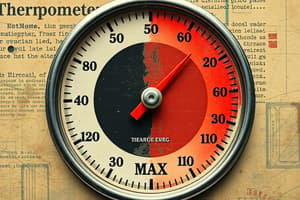Podcast
Questions and Answers
What is the temperature danger zone?
What is the temperature danger zone?
- Below 32 F
- 32 F and 40 F
- 41 F and 135 F (correct)
- 136 F and 165 F
What temperature range do foodborne pathogens grow most quickly?
What temperature range do foodborne pathogens grow most quickly?
41 F and 135 F
What is a thermometer?
What is a thermometer?
An instrument for measuring and indicating internal temperature
Where do you place a thermometer?
Where do you place a thermometer?
How long do you record a temperature of food?
How long do you record a temperature of food?
What does TCS stand for?
What does TCS stand for?
Flashcards are hidden until you start studying
Study Notes
Temperature Danger Zone
- The temperature danger zone for food safety is defined as between 41°F and 135°F.
- This zone is critical as foodborne pathogens proliferate rapidly within this temperature range.
Growth of Foodborne Pathogens
- Pathogens grow most quickly between 41°F and 135°F.
- Maintaining food outside this range is vital to prevent foodborne illness.
Thermometer Usage
- A thermometer is an instrument used to measure and indicate the internal temperature of food accurately.
- Proper usage is essential for ensuring food is cooked and stored safely.
Thermometer Placement
- To accurately measure temperature, a thermometer should be placed in the thickest part of the food.
- This ensures that the reading reflects the true internal temperature, avoiding cold spots.
Temperature Recording Duration
- Food temperature should be recorded after allowing the thermometer to stabilize for 15 seconds.
- This duration ensures an accurate temperature reading for safety compliance.
TCS Definition
- TCS stands for Temperature Controlled for Safety.
- This term is used to identify foods that require specific temperature controls to reduce the risk of foodborne illnesses.
Studying That Suits You
Use AI to generate personalized quizzes and flashcards to suit your learning preferences.




